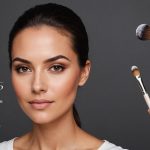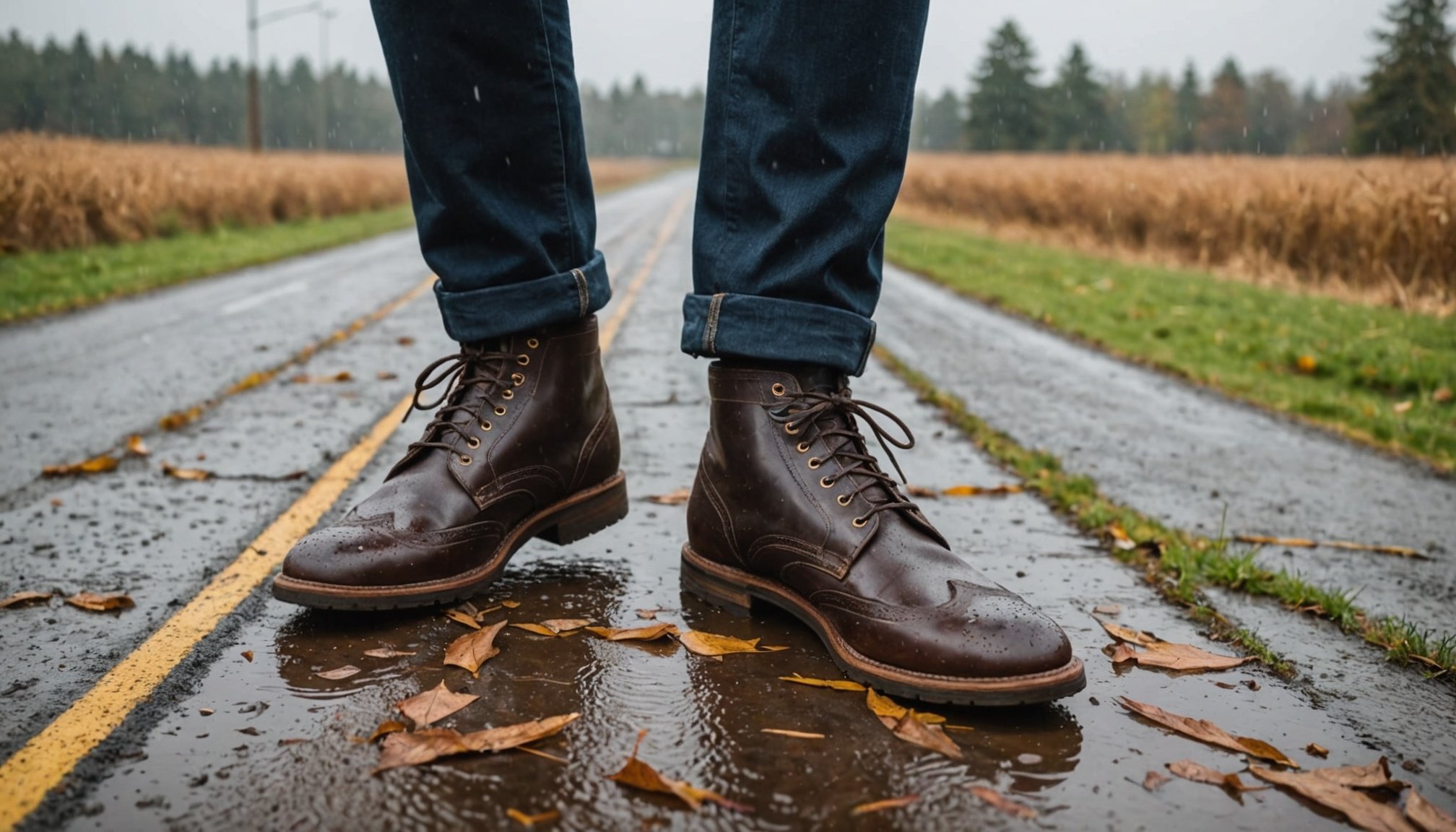Understanding Leather and Its Vulnerability to Wet Weather
Leather is integral to shoe manufacturing due to its durability and classic appeal; however, its interaction with moisture often leads to unanticipated challenges. Recognising how moisture affects different types of leather is essential for shoe care. For instance, full-grain leather, known for its strength, can become stiff and crack if exposed to excessive moisture, while suede is extremely vulnerable to water stains and deformation.
Despite the common perception of leather’s robustness, it’s crucial to acknowledge its susceptibility to moisture. A prevalent misconception is that all leather types share equal resistance to water. This misunderstanding can lead to inadequate leather care, resulting in damage.
Also to discover : Master Your Makeup: The Definitive Guide to Effortlessly Organizing for Instant Access;232Achieve Glowing Skin All Year: Expert Seasonal Skincare Tips for Radiant Beauty
Leather’s natural fibres easily absorb water, causing it to swell and then dry rigidly, which hampers its longevity. Understanding your leather’s specific needs is pivotal. This includes knowing the type of leather and its moisture threshold and applying the correct moisture protection measures.
In summary, safeguarding leather shoes requires respecting their vulnerabilities. Ensuring appropriate care and protection strategies can maintain their aesthetic and functional longevity, making your leather shoes a lasting investment.
Also to see : Transform your morning ritual: unlock enhanced focus with expert mindful breathing techniques for meditation
Preventative Measures for Leather Shoes
When it comes to shoe protection, employing effective waterproofing techniques is paramount. First, choose a waterproofing spray compatible with your shoe’s specific leather type, as each leather type demands tailored care. These sprays vary in formulation; some are silicone-based, enhancing moisture resistance, while others use natural ingredients to maintain breathability.
Begin by cleaning your shoes with a gentle leather cleaner to remove dirt and oils that may hinder waterproofing treatments’ effectiveness. Allow them to dry thoroughly before applying any product. This ensures maximum adhesion of the waterproof layer.
Pro maintenance tips recommend applying waterproof treatments evenly across the shoe’s surface. It is vital to cover all exposed areas without oversaturating, which could lead to discolouration. Regularly reapply treatments, especially after prolonged exposure to wet conditions, to maintain their efficacy.
Incorporate these best practices into your routine: test the product on a small, inconspicuous area first, and follow manufacturer instructions explicitly. Remember, consistency in maintenance routines profoundly influences the shoe’s lifespan and moisture protection capabilities. Thus, crafting a meticulous waterproofing strategy tailored to your shoes’ specifications significantly enhances their resistance to wet weather.
Recommended Products for Protecting Leather Shoes
When it comes to prolonging the life of your leather shoes, selecting the right protection products is crucial. Well-chosen products not only shield against moisture but also maintain the leather’s natural beauty.
Top Waterproofing Sprays
Waterproof sprays are invaluable for shoe protection. These sprays come in different formulations, such as silicone-based, which offer enhanced protection, or natural ingredient-based to preserve breathability. Aligning the spray choice with your specific leather type ensures optimal efficacy.
Best Leather Conditioners
Leather conditioners are vital for keeping leather pliable and hydrated. They replenish natural oils lost through wear, helping prevent drying and cracking. Choose conditioners that are compatible with your leather type, ensuring they penetrate and nourish the fibres adequately.
Essential Maintenance Tools
Invest in essential maintenance tools to accompany your care regimen. A soft brush for cleaning, clean cloths for application, and storage baskets for orderly storage underscore your maintenance strategy. With these tools, executing a thorough care routine becomes more straightforward and effective.
Ultimately, informed product choices based on leather type and maintenance requirements advance the integrity and aesthetics of your cherished leather shoes.
Detailed Maintenance Routine for Wet Weather
Caring meticulously for leather shoes, particularly during wet weather, involves a well-structured maintenance routine. Essential steps need to be included to ensure your shoes remain in excellent condition.
Start by gently removing any surface dirt with a soft, clean cloth. For embedded grime, use mild leather-specific cleaning tips, ensuring not to saturate the leather, which might lead to staining. Always test new cleaning products on a small, inconspicuous area first.
Once clean, drying techniques without compromising leather integrity are crucial. Air drying is the best method; avoid direct heat sources like radiators or hair dryers, which can cause leather to crack. Instead, stuff the shoe with newspaper to absorb excess moisture and help maintain shape.
Finally, integrate routine checks into your regimen. Regularly inspect your shoes for early signs of wear or potential damage, such as water rings or texture changes. Identifying these issues early can save you time and effort in more extensive repairs—keeping your leather shoes protected from moisture and ensuring they are always ready for use, regardless of the weather.
Troubleshooting Water Damage on Leather Shoes
Experiencing water damage on leather shoes can be frustrating, but timely intervention can often mitigate severe consequences. Identifying the type of damage is the first step; common issues include water stains, texture changes, and discolouration. Restoration techniques can vary depending on the severity of the damage.
For minor water stains, a gentle approach with a damp cloth followed by air drying is recommended. Always avoid direct heat sources to prevent further damage. For more stubborn marks, a mix of vinegar and water applied with a soft cloth can help restore leather to its original state.
In cases where DIY efforts are insufficient, assessing when to turn to professional shoe repair services is key. Professionals can address deeper issues and employ methods such as rehydration of the leather or replacement of damaged sections, ensuring your shoes are both aesthetically and functionally rejuvenated.
Routine checks and prompt addressing of damages can significantly reduce the need for extensive repair processes. Balancing DIY methods with expert interventions when needed maintains the health of your leather footwear, prolonging its lifespan and saving costs in the long run. Always ensure repairs are compatible with the specific leather type to avoid unintended deterioration.
Long-term Care Strategies for Leather Shoes
Taking good care of leather shoes is essential for the longevity and beauty of your footwear. Incorporating effective long-term maintenance can significantly extend the life of your shoes, ensuring they remain in top condition through various seasons and climates.
Storage Tips
Proper storage is crucial for preserving leather integrity. Always keep your shoes in a cool, dry place away from direct sunlight, which can cause fading and drying. Consider using shoe trees to maintain shape and absorb residual moisture. Use breathable shoe bags to minimise dust accumulation.
Seasonal Care
Adjust your leather care routine with the seasons. During wetter months, increase the frequency of waterproofing applications. In dry seasons, focus more on conditioning to prevent cracking due to lack of moisture. Tailoring your care routine to weather changes ensures shoes remain flexible and resilient.
Regular Conditioning
Consistent conditioning is essential to keep leather supple. Use a quality leather conditioner at least once a month, ensuring even application across the surface. Conditioning not only enhances moisture protection but also revives the leather’s natural oils and appearance, preventing premature wear.
Adhering to these strategies ensures that leather shoes remain an enduring component of your wardrobe, combining style with durability.






